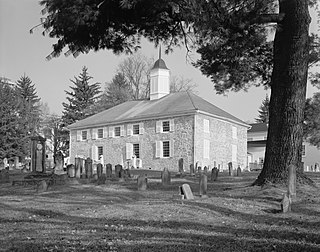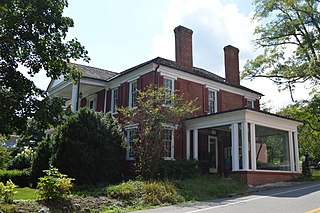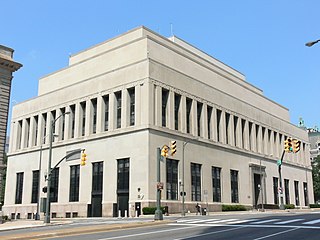
Greenbrier County is a county in the U.S. state of West Virginia. As of the 2020 census, the population was 32,977. Its county seat is Lewisburg. The county was formed in 1778 from Botetourt and Montgomery counties in Virginia.

Lewisburg is a city in and the county seat of Greenbrier County, West Virginia, United States. The population was 3,930 at the 2020 census.

The Greenbrier is a luxury resort located in the Allegheny Mountains near White Sulphur Springs in Greenbrier County, West Virginia, in the United States.

Bethany College is a private liberal arts college in Bethany, West Virginia. Founded in 1840 by Alexander Campbell of the Restoration Movement, who gained support by the Virginia legislature, Bethany College was the first institution of higher education in what is now West Virginia.

Hot Springs is a census-designated place (CDP) in Bath County, Virginia, United States. The population as of the 2010 Census was 738. It is located about 5 miles southwest of Warm Springs on U.S. Route 220.

Cass is a census-designated place (CDP) and unincorporated community on the Greenbrier River in Pocahontas County, West Virginia, United States. The population was 38 at the 2020 census. The community, founded in 1901, was named for Joseph Kerr Cass, vice president and cofounder of the West Virginia Pulp and Paper Company.

This is a list of properties and historic districts in West Virginia that are listed on the National Register of Historic Places. There are listings in every one of West Virginia's 55 counties.

The West Virginia State Capitol is the seat of government for the U.S. state of West Virginia, and houses the West Virginia Legislature and the office of the Governor of West Virginia. Located in Charleston, West Virginia, the building was dedicated in 1932. Along with the West Virginia Executive Mansion it is part of the West Virginia Capitol Complex, a historic district listed on the National Register of Historic Places.

West Virginia Independence Hall is a historic government building at 1528 Market Street in downtown Wheeling, West Virginia, United States. It was built in 1860 under the supervision of architect Ammi B. Young for the federal government as a custom house, post office and courthouse. It is architecturally significant for its innovative uses of wrought iron as a framing material, and is historically significant for its role in the American Civil War. It housed the Wheeling Convention (1861), as well as the West Virginia Constitutional Convention (1863), which resulted in the separation of Unionist West Virginia from Confederate Virginia. This made it the only state to secede from a Confederate state during the war. The building was originally built as the custom house for the Western District of Virginia, and later became the center of government for the Restored Government of Virginia from 1861 to 1863, with Francis H. Pierpont serving as its governor. It was declared a National Historic Landmark in 1988. The building is now a state-run museum, housing exhibits on West Virginia history.

The Robert Russa Moton Museum is a historic site and museum in Farmville, Prince Edward County, Virginia. It is located in the former Robert Russa Moton High School, considered "the student birthplace of America's Civil Rights Movement" for its initial student strike and ultimate role in the 1954 Brown v. Board of Education case desegregating public schools. It was designated a National Historic Landmark in 1998, and is now a museum dedicated to that history. In 2022 it was designated an affiliated area of Brown v. Board of Education National Historical Park. The museum were named for African-American educator Robert Russa Moton.

This is a list of the National Register of Historic Places listings in Greenbrier County, West Virginia.

The Pearl S. Buck Birthplace is a historic home in Hillsboro, West Virginia where American writer Pearl S. Buck was born. The home now serves as a museum offering guided tours. The site also includes a carpentry shop and barn with over 100 historic farm and woodworking tools, and the log home of Buck's father's family, the Sydenstrickers, which was moved from Greenbrier County.

Old Stone Church is a historic Presbyterian church located at Lewisburg, Greenbrier County, West Virginia.

The John A. North House is a historic house museum and archives located in Lewisburg, Greenbrier County, West Virginia. Currently, the North House is Greenbrier County's only historic house museum. Since 1976, The Greenbrier Historical Society has operated within the North House, and in 1992 the North House was officially purchased by the Greenbrier Historical Society. In 1992, the home officially became known as "North House Museum, Greenbrier Historical Society."
Stuart Manor is a private historic home located near Lewisburg, Greenbrier County, West Virginia. The manor house was built in 1789. It is a long and low, two-story limestone building. It features thick gray walls and has a fort-like appearance. A two-story stone wing was added later, as were a number of frame additions. It features a verandah along two sides of the older wing. Also on the property is a one-room stone building built in 1778 and served as the county clerk's office for many years. The manor was home to Colonel John Stuart, considered the "Founder and Father of Greenbrier County." In 1884, "Gov." Samuel Price was interred in the Stuart Burying Ground.
Oakhurst Links is a historic golf course located at White Sulphur Springs, Greenbrier County, West Virginia. It was the first golf course in the United States. It is a nine-hole course built in 1884, in a design based upon traditional Scottish design elements. The first competition for the Oakhurst Links Challenge Medal was held in 1888.

Greenbrier County Courthouse is a historic courthouse building located at Lewisburg, Greenbrier County, West Virginia. In 1973 the courthouse and the adjacent spring house, the Lewis Spring, were listed on the National Register of Historic Places. and are a historic and

Lewisburg Historic District is a national historic district located at Lewisburg, Greenbrier County, West Virginia. The district encompasses 112 contributing buildings and are representative of the development and evolution of Lewisburg, over a period of more than two centuries (1763-1977). Notable buildings include log cabins dating to the period 1755–1769, "The Barracks," Mount Esperance (1814), Williams-Henning Store/house (1814-1820), Welch-Bell House (1824), John W. Dunn House, John Withrow's Store/ House (1836), Greenbrier Valley Bank Building (1897), and Carnegie Hall (1902). Located in the district and separately listed are the Old Stone Church, Greenbrier County Courthouse and Lewis Spring, John Wesley Methodist Church, Gov. Samuel Price House, Mt. Tabor Baptist Church, Supreme Court Library Building, James Withrow House, and John A. North House.

Weston Colored School, also known as the Central West Virginia Genealogical & Historical Library and Museum and Frontier School, is a historic one-room school building located at Weston, Lewis County, West Virginia. It was built in 1882, and is a single-story rubbed red brick building on a fieldstone foundation. It originally measured 22 feet by 28 feet, then enlarged in 1928 by 12 feet, 6 inches. It was used as an educational facility for the community's African-American youth until desegregation in 1954. It was subsequently used for storage, then an agricultural classroom for the Lewis County High School, and as a shop for mentally disabled students. It afterwards was used by the Central West Virginia Genealogical & Historical Library and Museum.

The Patrick Henry Building is a historic building located in Richmond, Virginia. Formerly designated simply as the Old State Library or the Virginia State Library and Archives and Virginia Supreme Court, it was renovated, then rededicated and renamed for the Founding Father and former Virginia Governor Patrick Henry on June 13, 2005.





















